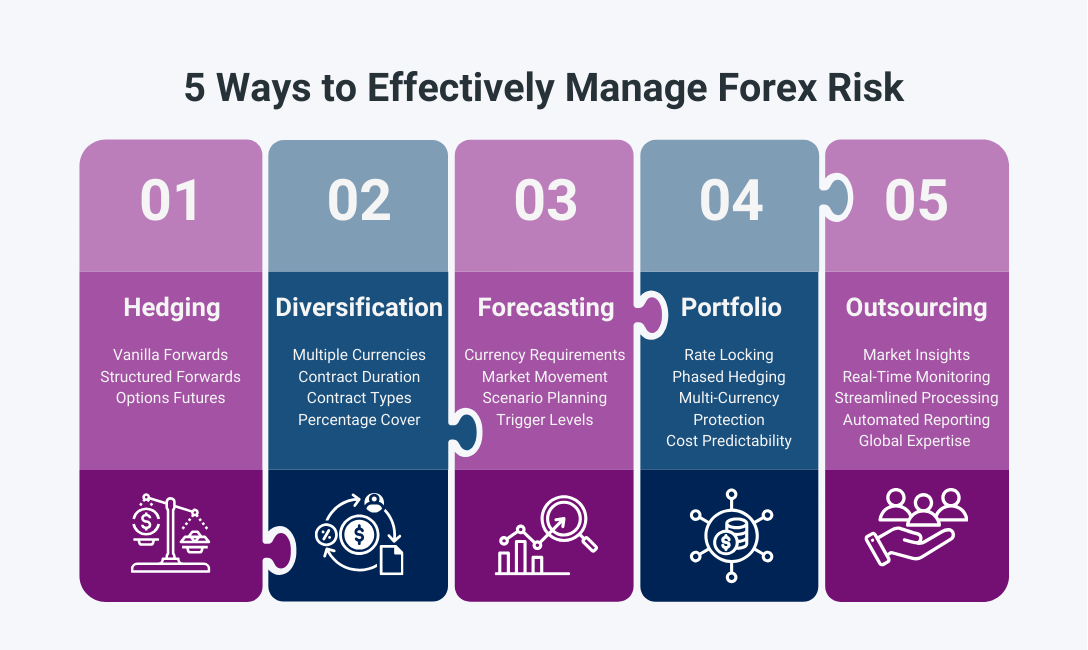Forex Management Insights
5 Ways to Effectively Manage Your Organisation's Forex Risk
Discover how to effectively manage forex risk with hedging, diversification, forecasting, portfolio strategies, and outsourcing.
-
Nicky Strydom
- 3 minutes read

Managing foreign exchange (FX) risk is a critical consideration for any company engaged in international business activities. Unpredictable currency movements can have a profound impact on profitability and cash flow.
Here are five robust strategies that a company can use to effectively manage its FX risk:
1. Hedging: Locking in Certainty Amidst Uncertainty
Hedging involves taking strategic positions in the currency market to shield against adverse currency movements. This is achieved using financial instruments that either lock in favourable rates or provide flexibility when markets shift.
Key Instruments for Hedging:
- Vanilla Forwards: These are straightforward contracts that lock in a specific exchange rate for a future date, allowing businesses to secure costs or revenues at a known rate and protect themselves from unexpected swings in currency value.
- Structured Forwards: More flexible than vanilla forwards, these can be customised to match specific business needs. They allow for some movement if market conditions change, offering protection while capturing potential upsides.
- Options: These financial tools provide the right but not the obligation to exchange currency at a predetermined rate. This is similar to an insurance policy—if the market rate is unfavourable, the business can exercise the option; if the market is favourable, it can let it expire.
- Futures: Standardised contracts that are traded on exchanges, locking in an exchange rate for a specific amount of currency at a set date. This is particularly useful for long-term financial planning where currency exposure is predictable.
Application in Business:
Hedging is ideal for companies with predictable cash flows in foreign currencies. For example, a manufacturing company exporting goods priced in US dollars may use vanilla forwards to protect against a weakening dollar, ensuring stable revenue in its local currency.
2. Diversification: Spreading Risk Across Borders and Instruments
At a business level, diversification is about spreading operational and financial exposure across multiple currencies and regions. This helps offset losses in one currency with gains in another, stabilising overall financial performance.
Treasury-Level Diversification:
In the context of treasury management, diversification extends beyond currencies. It also includes:
- Contract Duration: Using both short-term and long-term hedging contracts to balance exposure across different time frames. Short-term contracts allow for flexibility, while long-term contracts secure rates over extended periods.
- Contract Types: A mix of forwards, options, and swaps provides different levels of protection and cost certainty. For instance, options offer a safety net without locking you in, while forwards guarantee a set rate.
- Percentage Cover: Varying the percentage of exposure hedged prevents overcommitment. For example, hedging 70% of expected revenue allows for some market play while still safeguarding the majority of exposure.
Application in Business:
A global IT services company operating across Europe, the US, and Asia might use diversified hedging strategies to stabilise its income. If the dollar weakens, more substantial revenues from Europe or Asia can balance the impact.
3. Forecasting: Anticipating the Future to Secure the Present
Effective forecasting is fundamental to successful FX risk management. This involves predicting future currency needs and market movements based on historical data, economic indicators, and geopolitical events.
Elements of Effective Forecasting:
- Currency Requirements Forecasting: Estimating how much of each currency will be needed over time, allowing companies to hedge accordingly.
- Market Movement Forecasting: Using economic analysis to predict currency trends and identify optimal times to hedge or adjust exposure.
- Scenario Planning: Building scenarios for best-case, worst-case, and most-likely outcomes helps prepare for a range of market conditions.
- Trigger Levels: Establishing price points where hedging actions are automatically initiated. This reduces emotional decision-making and locks in favourable rates during volatility.
Application in Business:
A retail chain with suppliers across Europe may use forecasting to plan its currency needs, setting trigger levels for hedging when the euro is favourable. This reduces the risk of sudden cost increases if the euro strengthens unexpectedly.
“We’re not witnessing a dollar collapse – but we are seeing a multipolar currency system emerge. That changes everything for global contracts and treasury policy.” ~ Sharon Constançon, CEO | Valufin
4. Portfolio Approach: Building a Safety Net Across Projects and Timeframes
A portfolio approach to FX risk management is about creating a strategic mix of hedging contracts that are spread across different projects, timeframes, and exposure levels. This strategy aims to minimise risk while optimising opportunities.
Key Elements of the Portfolio Approach:
- Rate Locking: Securing favourable exchange rates for critical project phases reduces uncertainty.
- Phased Hedging: Breaking down exposure into smaller time segments allows for adjustments based on market changes.
- Multi-Currency Protection: For multinational projects, using different instruments to hedge each currency reduces the overall risk.
- Cost Predictability: Budgeting becomes more precise, as major cost components are protected from market swings.
Application in Business:
A construction company managing a multi-year project in multiple countries might use a portfolio of forwards and options to lock in rates for each stage of the project, ensuring costs remain predictable despite currency fluctuations.
5. Outsourcing Your FX Management: Leveraging Expertise and Technology
For many businesses, managing foreign exchange (FX) risk in-house is both resource-intensive and complex. Outsourcing to a specialist like Valufin can offer:
- Market Insights: Access to real-time analysis and expert advisory, ensuring hedging strategies are aligned with market conditions.
- Advanced IT Systems: Streamlined transaction processing, real-time monitoring, and automated reporting reduce administrative burden.
- Global Expertise: Custom solutions to manage multi-currency exposures and regulatory compliance across borders.
Application in Business:
A medium-sized manufacturer expanding into multiple markets may find foreign exchange (FX) management too complex to handle internally. By partnering with Valufin, they can offload the risk and complexity, allowing their finance team to focus on growth and strategic planning.
Take Control of Your FX Risk
Managing FX risk is not just about protecting margins—it’s a strategic lever for growth, resilience, and long-term success. Through hedging, diversification, forecasting, a portfolio approach, and outsourcing, businesses can confidently navigate currency volatility.
Valufin empowers your organisation with tailored insights, expert execution, and technology-driven solutions. Let’s transform uncertainty into opportunity.
Speak with our team today to take control of your foreign exchange (FX) risk.
Secure Your Business Against Currency Volatility
Transform risk into opportunity with your trusted partner in Forex Management. Speak to our experts today.












